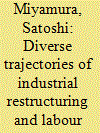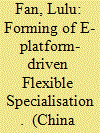| Srl | Item |
| 1 |
ID:
148276


|
|
|
|
|
| Summary/Abstract |
It is often claimed that industrial restructuring leads to diminished roles for trade unionism and other forms of labour organisations by informalising employment and relocating production. Drawing on selected case studies from long-term fieldwork in regions of India, this article shows that trajectories of industrial restructuring and the responses by organised labour over the past two decades have been diverse. It is argued that the diverse response not only reflects structural opportunities and constraints for labour to be organised in particular ways, but also different histories and experiences of labour association. Contrary to the presumption about the general demise of trade unionism and the apparent unattainability of class solidarity in contemporary globalised capitalism, it is observed that India’s labour movement is experiencing a degree of resurgence, and new forms of labour organisations and activism are emerging, especially involving informal workers in the formal sector. That these innovative forms of mobilisation are shaped by experiences and aspirations that do not conform to the established institutionalised frameworks for dispute resolution has important policy and political implications.
|
|
|
|
|
|
|
|
|
|
|
|
|
|
|
|
| 2 |
ID:
181888


|
|
|
|
|
| Summary/Abstract |
E-commerce platforms have promoted the rise of consumer-demand-driven supply chains in the garment industry. This kind of supply chain has raised the demand for a new type of production organisation exemplified by low processing costs, small batches, multi-varieties, and quick reorders. Drawing on the insights of flexible specialisation theory, this paper proposes the concept of e-platform-driven flexible specialisation to describe this emerging production organisation form. This flexible specialisation is characterised by highly fragmented and informal production organisations such as husband-and-wife-run workshops and production units based on daily wage workers. In the context of a severe labour shortage in the garment industry, workers participate in the construction of these informal production organisations in order to obtain higher wages and work autonomy. However, the increase in informal employment also makes garment workers more atomised and vulnerable to social risks such as the outbreak of COVID-19. It is necessary to innovate labour relation negotiation modes to cope with the impacts of the rise of the platform economy on labour relations.
|
|
|
|
|
|
|
|
|
|
|
|
|
|
|
|
| 3 |
ID:
165370


|
|
|
|
|
| Summary/Abstract |
This article undertakes an examination of Bangladesh’s latest available Quarterly Labour Force Survey 2015–2016 data to draw in-depth insights on gender wage gap and wage discrimination in Bangladesh labour market. The mean wage decomposition shows that on average a woman in Bangladesh earns 12.2 per cent lower wage than a man, and about half of the wage gap can be explained by labour market discrimination against women. Quantile counterfactual decomposition shows that women are subject to higher wage penalty at the lower deciles of the wage distribution with the wage gap varying between 8.3 per cent and 19.4 per cent at different deciles. We have found that at lower deciles, a significant part of the gender wage gap is on account of the relatively larger presence of informal employment. Conditional quantile estimates further reveal that formally employed female workers earn higher wage than their male counterparts at the first decile but suffer from wage penalty at the top deciles.
|
|
|
|
|
|
|
|
|
|
|
|
|
|
|
|